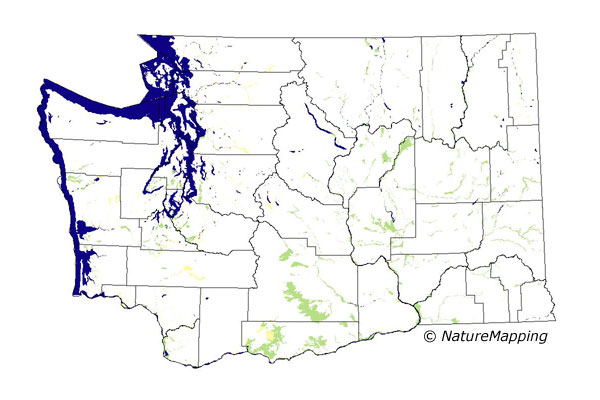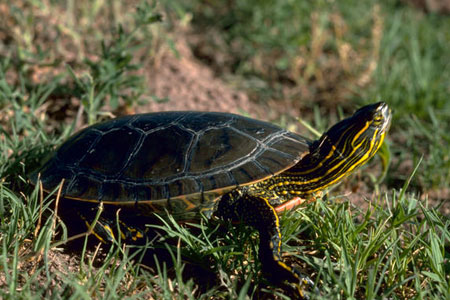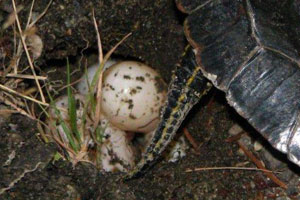


Painted Turtle (Chrysemys picta) Description: Painted turtles are brightly marked. They have a smooth shell about 90 to 250 mm long. The painted turtle has a relatively flat upper shell with red and yellow markings on a black or greenish brown background. Due to their similar size and coloration, they are often confused with the Red-eared slider [ see comparison guide ] 
Range/ Habitat: Painted turtles are one of the most common turtles in North America and are found from southern Canada to northern Mexico. This turtle lives in ponds, lakes, marshes, and in slow-moving rivers that have soft, muddy bottoms. Click the map for information about the habitat and range of the Painted Turtle in Washington. Diet: Painted turtles feed mainly on plants and small animals, such as fish, crustaceans, and aquatic insects. Turtles don't have teeth, but instead have horny ridges that are serrated and sharp on their upper and lower jaws. 
Reproduction: The breeding season lasts from late spring to early summer. Painted turtles are amniotes which requires females to nest on land. Females prefer soft, sandy soil with good exposure to the sun for their nest site. Nests are dug with the turtle's hind feet, usually within 200 meters of water. The nest is no deeper than 10 to 12 centimeters. The females will lay 4 to 15 oval, soft shelled eggs, in a flask-shaped hole in the ground (see photo). Development: The sex of the turtle is determined during a critical phase of embryogenesis according to the incubation temperature. These temperature-dependent reptiles lack sex chromosomes that determine gender. Low temperatures during incubation produce males and high temperatures produce females. Hatchlings have two threshold temperatures, 27 to 32 C and 22 C. These thresholds may be important to some northern or woodland populations. 
Behavior: Raccoons, otters, mink, foxes, and other medium-sized animals will prey on turtles and their eggs. Painted turtles keep a watch out for predators and seek refuge in the water at the first sign of danger. For protection, they can quickly retract their head and legs into their hard shell. Painted turtles bask in groups on logs, fallen trees, and other objects near water (see photo below). The sun exposure helps rid them of parasites. In many areas turtles hibernate during the winter months by burrowing into the mud.
Did you know?
More Information: Painted Turtle - Animal Diversity Web Animal silhouettes available to purchase » Photos: U.S. Fish & Wildlife Service (top image); Vanessa Kilburn (eggs, hatchling, habitat) Home | About Us | How to Participate | Biodiversity Modules | Projects | Maps | News | Resources |